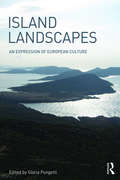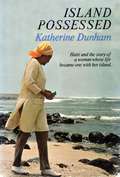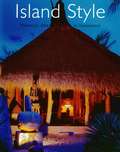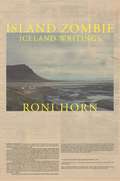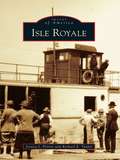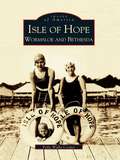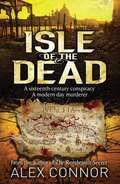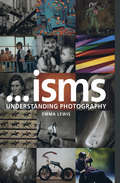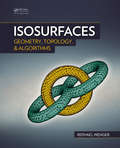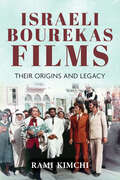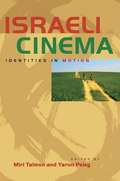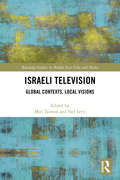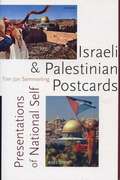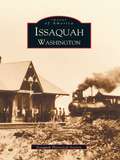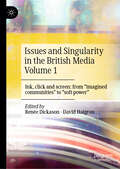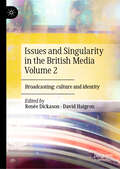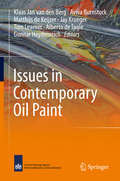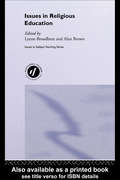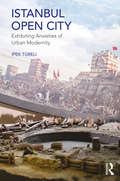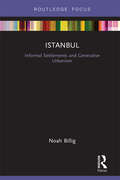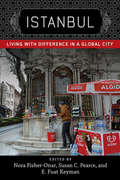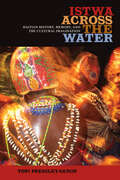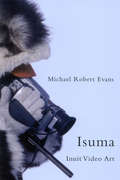- Table View
- List View
Island Landscapes: An Expression of European Culture
by Gloria PungettiIsland Landscapes takes a critical look at the evolution of European islandscapes and seascapes to examine the conditions facing them in the twenty first century. Considering island landscapes as an expression of European culture, this book envisages future trends and presents clearly the need to find a balance between preservation and development to ensure sustainability. Both large and small islands are illustrated in the book including the British Isles, Malta and Cyprus as well as archipelagos in Norway, Italy and Greece. Their unique identities and values reveal the remarkable breadth of cultural heritage possessed by these diverse European islands. An interdisciplinary approach is applied to the history, perception, characterisation and planning of islandscape and seascape in Europe, to support culturally-oriented strategies for these fragile landscapes.
Island Possessed
by Katherine DunhamJust as surely as Haiti is "possessed" by the gods and spirits of vaudun (voodoo), the island "possessed" Katherine Dunham when she first went there in 1936 to study dance and ritual. In this book, Dunham reveals how her anthropological research, her work in dance, and her fascination for the people and cults of Haiti worked their spell, catapulting her into experiences that she was often lucky to survive. Here Dunham tells how the island came to be possessed by the demons of voodoo and other cults imported from various parts of Africa, as well as by the deep class divisions, particularly between blacks and mulattos, and the political hatred still very much in evidence today. Full of the flare and suspense of immersion in a strange and enchanting culture,Island Possessedis also a pioneering work in the anthropology of dance and a fascinating document on Haitian politics and voodoo.
Island Style
by Jacob Termansen Gillian BealFrom medieval times, travelers have returned from the East bringing designs, artifacts and architectural ideas with them. The Indonesian archipelago - with its myriad peoples, cultures, and arts and crafts traditions - has long been a source of particular inspiration, Now many are choosing to stay there(or indeed are returning home) and building dream retreats in their natural tropical settings. Island Style showcases over 25 such dwellings - be they private homes, resort villas or island hideaways all harness Indonesia's unique architectural and design ethos and meld it with Western aesthetics. Simple yet exotic, clean lined and contemporary, metropolitan or in more remote locations. In addition, there are plenty of practical design ideas for interiors, doorways, walls, furnishings, furniture and lighting. Photographed entirely on location, Island Style showcases the application of Eastern ideals in any global setting.
Island Style
by Jacob Termansen Gillian BealFrom medieval times, travelers have returned from the East bringing designs, artifacts and architectural ideas with them. The Indonesian archipelago - with its myriad peoples, cultures, and arts and crafts traditions - has long been a source of particular inspiration, Now many are choosing to stay there(or indeed are returning home) and building dream retreats in their natural tropical settings. Island Style showcases over 25 such dwellings - be they private homes, resort villas or island hideaways all harness Indonesia's unique architectural and design ethos and meld it with Western aesthetics. Simple yet exotic, clean lined and contemporary, metropolitan or in more remote locations. In addition, there are plenty of practical design ideas for interiors, doorways, walls, furnishings, furniture and lighting. Photographed entirely on location, Island Style showcases the application of Eastern ideals in any global setting.
Island Zombie: Iceland Writings
by Roni HornAn evocative chronicle of the power of solitude in the natural worldI’m often asked, but have no idea why I chose Iceland, why I first started going, why I still go. In truth I believe Iceland chose me.—from the introductionContemporary artist Roni Horn first visited Iceland in 1975 at the age of nineteen, and since then, the island’s treeless expanse has had an enduring hold on Horn’s creative work. Through a series of remarkable and poetic reflections, vignettes, episodes, and illustrated essays, Island Zombie distills the artist’s lifelong experience of Iceland’s natural environment. Together, these pieces offer an unforgettable exploration of the indefinable and inescapable force of remote, elemental places, and provide a sustained look at how an island and its atmosphere can take possession of the innermost self.Island Zombie is a meditation on being present. It vividly conveys Horn’s experiences, from the deeply profound to the joyful and absurd. Through powerful evocations of the changing weather and other natural phenomena—the violence of the wind, the often aggressive birds, the imposing influence of glaciers, and the ubiquitous presence of water in all its variety—we come to understand the author’s abiding need for Iceland, a place uniquely essential to Horn’s creative and spiritual life. The dramatic surroundings provoke examinations of self-sufficiency and isolation, and these ruminations summon a range of cultural companions, including El Greco, Emily Dickinson, Judy Garland, Wallace Stevens, Edgar Allan Poe, William Morris, and Rachel Carson. While brilliantly portraying nature’s sublime energy, Horn also confronts issues of consumption, destruction, and loss, as the industrial and man-made encroach on Icelandic wilderness.Filled with musings on a secluded region that perpetually encourages a sense of discovery, Island Zombie illuminates a wild and beautiful Iceland that remains essential and new.
Isle Royale
by Richard E. Taylor Jessica J. PoyerThis history of Isle Royale traces almost 5,000 years of human efforts to harvest its natural resources. From the Paleo-Indians who extracted native copper to the 19th-century miners, fishermen, farmers, and sportsmen, this isle apart has been visited, mined, and plundered for centuries. Under the protection of the National Park Service since 1940, the island is returning to the natural regime that preceded the arrival of the first humans. Moose, wolves, and bald eagles now share the island with low-impact campers and boaters. The reader will visit the lighthouses, steamships, fish camps, and resorts and the people of the last two centuries who left their footprints on this jewel of Lake Superior.
Isle of Hope: Wormsloe and Bethesda
by Polly Wylly CooperIsle of Hope, Georgia, nine miles south of Savannah, is a charming settlement with a story reaching back into the 1700s. Visitors to the area marvel at scenic views along the Skidaway River, grand homes built by early Savannahians, numerous historic sites, abundant wildlife, and water sports. This treasured lifestyle is one that islanders have waged heated battles to protect, and their collective experience is celebrated within the pages of this impressive pictorial volume. An original land grant from King George II of England, photographs of early families, streetcars, Barbee's Pavilion, the original Mysterious Santa Claus, sailboat racing, and more are among the many notable items included in Isle of Hope, Wormsloe, and Bethesda. Wormsloe Plantation, home of Noble Jones built on land leased from the trustees of the colony of Georgia in 1736, is highlighted here, as well as the nearby community of Dutch Island, where Matthew Batson conducted his legendary aero-yacht experiments in 1913. Bethesda, founded in 1740 by Rev. George Whitefield and now America's oldest existing home for boys, comes to life in vintage photographs and a touching poem written by an orphan in 1917. Images culled from both public and private collections evoke memories of a way of life almost extinct in today's frantic world-a way of life held steadfast by the residents of this singular Georgia community.
Isle of the Dead
by Alex ConnorIn the dark winter of 1555 the flayed bodies of young women are washing up on the banks of the Venice's canals. When Angelico Vespucci, whose portrait was painted by the Italian master Titian, is discovered to be the monster responsible for these horrific crimes, he inexplicably vanishes along with the painting. All that remains was the chilling warning that when the portrait emerges, so will the man. Now, the lost Titian masterpiece has surfaced in modern-day London, and skinless corpses are amassing all around the world. And it will fall to Nino Bergstrom, the adopted son of a retired art dealer, to unravel half a millennium of myth, mystery, and murder.
Isms: Understanding Photography
by Emma LewisUnderstanding Photography packs an enormous amount of detail into a handy, attractive guide tracing the evolution of photography through a series of interconnected trends, groups, themes and movements – from the invention of the photographic process to the post-internet age. Organised chronologically, this is a uniquely international, comprehensive guide to photography with concise, readable and jargon-free but scholarly insight into major photographers, movements and themes of the past 170 years. In an age where photography is of more resonance and interest than ever before, Understanding Photography offers an in-depth and clear exposition of photography for the interested general reader or student.
Isosurfaces: Geometry, Topology, and Algorithms
by Rephael WengerEver since Lorensen and Cline published their paper on the Marching Cubes algorithm, isosurfaces have been a standard technique for the visualization of 3D volumetric data. Yet there is no book exclusively devoted to isosurfaces. Isosurfaces: Geometry, Topology, and Algorithms represents the first book to focus on basic algorithms for isosurface co
Israeli Bourekas Films: Their Origins and Legacy (Sephardi and Mizrahi Studies)
by Rami KimchiA genre of comic melodramas produced in the 1960s and '70s, Bourekas films are among the most popular films ever made in Israel. In Israeli Bourekas Films, author and filmmaker Rami Kimchi sets out a history of Bourekas films and discusses their origin.Kimchi considers the representation of Sephardi or Mizrahi Jews in the films, noting that the material culture reflected in the the films presented a culture that was closer to the European Yiddish culture than to the Middle Eastern world of the Mizrahim. Kimchi reflects on the enormous popularity and commercial success of Bourekas films, uncovers how they were made, who made them and why, and discusses the impact of the films on Israeli cinema today. Israeli Bourekas Films is a film insider's view of the characters, stories, and cultures that made Bourekas films such an important part of Israeli life.
Israeli Cinema
by Miri Talmon Yaron PelegWith top billing at many film forums around the world, as well as a string of prestigious prizes, including consecutive nominations for the Best Foreign Film Oscar, Israeli films have become one of the most visible and promising cinemas in the first decade of the twenty-first century, an intriguing and vibrant site for the representation of Israeli realities. Yet two decades have passed since the last wide-ranging scholarly overview of Israeli cinema, creating a need for a new, state-of-the-art analysis of this exciting cinematic oeuvre. The first anthology of its kind in English, Israeli Cinema: Identities in Motion presents a collection of specially commissioned articles in which leading Israeli film scholars examine Israeli cinema as a prism that refracts collective Israeli identities through the medium and art of motion pictures. The contributors address several broad themes: the nation imagined on film; war, conflict, and trauma; gender, sexuality, and ethnicity; religion and Judaism; discourses of place in the age of globalism; filming the Palestinian Other; and new cinematic discourses. The authors’ illuminating readings of Israeli films reveal that Israeli cinema offers rare visual and narrative insights into the complex national, social, and multicultural Israeli universe, transcending the partial and superficial images of this culture in world media.
Israeli Television: Global Contexts, Local Visions (Routledge Studies in Middle East Film and Media)
by Yael Levy Miri TalmonThe essays in this anthology study Israeli television, its different forms of representation, audiences and production processes, past and present, examining Israeli television in both its local, cultural dynamics, and global interfaces. The book looks at Israeli television as a creator, negotiator, guardian and warden of collective Israeli memory, examining instances of Israeli original television exported and circulated to the US and the global markets, as well as instances of American, British, and global TV formats, adapted and translated to the Israeli scene and screen. The trajectory of this volume is to shed light on major themes and issues Israeli television negotiates: history and memory, war and trauma, Zionism and national disillusionment, place and home, ethnicity in its unique local variations of Ashkenazim and Mizrahim, immigrants from the former Soviet Union and Ethiopia, Israeli–Arabs and Palestinians, gender in its unique Israeli formations, specifically masculinity as shaped by the military and constant violent conflict, femininity in this same context as well as within a complex Jewish oriented society, religion, and secularism. Providing multifaceted portraits of Israeli television and culture in its Middle Eastern political and local context, this book will be a key resource to readers interested in media and television studies, cultural studies, Israel, and the Middle East.
Israeli and Palestinian Postcards: Presentations of National Self
by Tim Jon SemmerlingSearing images of suicide bombings and retaliatory strikes now define the Israeli-Palestinian conflict for many Westerners, but television and print media are not the only visual realms in which the conflict is playing out. Even tourist postcards and greeting cards have been pressed into service as vehicles through which Israelis and Palestinians present competing visions of national selfhood and conflicting claims to their common homeland. In this book, Tim Jon Semmerling explores how Israelis and Palestinians have recently used postcards and greeting cards to present images of the national self, to build national awareness and reinforce nationalist ideologies, and to gain international acceptance. He discusses and displays the works of numerous postcard/greeting card manufacturers, artists, and photographers and identifies the symbolic choices in their postcards, how the choices are arranged into messages, what the messages convey and to whom, and who benefits and loses in these presentations of national self. Semmerling convincingly demonstrates that, far from being ephemeral, Israeli and Palestinian postcards constitute an important arena of struggle over visual signs and the power to produce reality.
Issaquah, Washington
by Issaquah Historical SocietyIncorporated as Gilman in 1892, Issaquah was among the earliest communities settled on the east side of Lake Washington. By 1900, immigrants and newcomers were flooding into the town now known as Issaquah to work the mines, mill lumber, and establish farms and businesses. Though the town's growth dwindled with the coal market in the 1920s, families first attracted by the area's business opportunities stayed because they loved the close-knit community. In 1940 the first bridge across Lake Washington heralded a new era of growth, bringing Issaquah within an hour's drive of Seattle. By the time Interstate 90 came through town in the early 1970s, many trademarks of the small town were fading.This collection of photographs, many never before published, illustrates Issaquah's heyday of mining and logging, its quiet years as a rural community, and its recent transformation into a thriving city. Included are scenes of local events such as the annual Issaquah rodeo, the Squak Valley Hot Shots musical group, and the Issaquah Skyport air show. The deconstruction of architectural symbols such as the Issaquah high trestle and an old pioneer home are also documented.
Issues and Singularity in the British Media Volume 1: Ink, click and screen: from "imagined communities" to "soft power"
by Renée Dickason David HaigronThis book offers a historical, cultural, political and socio-economic analysis of the British media. It examines how facts and events are reported and interpreted, but also how ideas and opinions circulate and are recycled, with attention being paid to British traits and tropes in these domains. This in-depth study of “issues” and “singularity” aims at understanding how the British media have helped shape the country’s culture and representations, thereby providing its people with a sense of togetherness. Volume 1 focuses on the press, the internet and cinema as mass media, from the prolific and innovative Victorian era – the matrix of the modern world – to the turn of the 21st century with the challenge of digitalisation. Newspapers, magazines, films and music are studied as vehicles for fostering shared collective identities (“imagined communities”) and for projecting a certain image of Britain at home and abroad (“soft power”).
Issues and Singularity in the British Media Volume 2: Broadcasting: culture and identity
by Renée Dickason David HaigronThis book offers a historical, cultural, political and socio-economic analysis of the British media. It examines how facts and events are reported and interpreted, but also how ideas and opinions circulate and are recycled, with attention being paid to British traits and tropes in these domains. This in-depth study of “issues” and “singularity” aims at understanding how the British media have helped shape the country’s culture and representations, thereby providing its people with a sense of togetherness. Volume 2 focuses on radio and (mostly) television broadcasting, from the interwar period to the early 21st century. In order to apprehend what is deeply engrained in British culture and thus contributes to shaping national identity, it analyses the ideas disseminated and reflected not only in programmes but also within media institutions in the face of changing political contexts, as well as providing a historiographical overview.
Issues in Contemporary Oil Paint
by Klaas Jan Berg Aviva Burnstock Matthijs Keijzer Jay Krueger Tom Learner Alberto Tagle Gunnar HeydenreichThis volume represents 27 peer-reviewed papers presented at the ICOP 2013 symposium which will help conservators and curators recognise problems and interpret visual changes on paintings, which in turn give a more solid basis for decisions on the treatment of these paintings. The subject matter ranges from developments of paint technology, working methods of individual artists, through characterisation of paints and paint surfaces, paint degradation vs. long time stability, to observations of issues in collections, cleaning and other treatment issues as well as new conservation approaches.
Issues in Religious Education (Issues in Teaching Series)
by Alan Brown Lynne BroadbentThis book is designed to give students and newly qualified teachers a contextual and theoretical background to this subject, by exploring and challenging assumptions about the place of religion in education.The book is divided into the following sections: section one sets out the context for religious education in the curriculum. It looks at political, social and religious influences on legislation, particularly in faith schools, and raises questions about assessment section two focuses on Religious Education in the classroom, exploring our understanding of religion and the concept of development in Religious Education section three examines Religious Education as a whole-school issue, considering its relationship to literacy, citizenship, collective worship and spiritual, ethical and moral development.
Istanbul, Open City: Exhibiting Anxieties of Urban Modernity
by Ipek TüreliUrban theory traditionally links modernity to the city, to the historical emergence of certain forms of subjectivity and the rise of important developments in culture, arts and architecture. This is often in response to technological, economic and societal transformations in the nineteenth- and early twentieth-centuries in select Euro-American metropolises. In contrast, non-Western cities in the modern period are often considered through the lens of Westernization and development. How do we account for urban modernity in "other" cities? <P><P> This book seeks to highlight cultural creativity by examining the diverse and shifting ways Istanbulites have defined themselves while they debate, imagine, build and consume their city. It focuses on a series of exhibitionary sites, from print press/photography, cinema/films, exhibitions of architectural heritage, theme parks and museums, and explores the links between these popular depictions through shared practices of representation. In doing so it argues that understanding how the future is imagined through images and interpretations of the past can broaden current theoretical thinking about Istanbul and other cities. <P><P> In line with postcolonial calls for a comparative urbanism that decouples understanding of the modern from its privileged association with Western cities, this book offers a new perspective on the lens of urban modernity. It will appeal to urban geographers and historians, cultural studies scholars, art historians and anthropologists as well as planners, architects and artists.
Istanbul: Informal Settlements and Generative Urbanism (Built Environment City Studies)
by Noah BilligIstanbul: Informal Settlements and Generative Urbanism analyzes two informal housing settlements in Istanbul, Turkey – Karanfilköy and Fatih Sultan Mehmet – to examine how generatively built structures and neighbourhoods can be successfully realized in a modern, burgeoning urban context. Generative development processes adapt to existing conditions and unfold over time, but there have been relatively few examples in the 20th and 21st centuries. This book evaluates the constructs of living structures, pattern languages and generative urban design processes in relation to Istanbul’s informal settlements. It provides examples of communities making liveable, dynamic and user-adapted neighbourhoods and establishes them as a modern settlement typology in generative urban design theory.
Istanbul: Living With Difference In A Global City (New Directions In International Studies)
by Charles King Susan C. Pearce E. Fuat Keyman Amy Mills Nora Fisher-Onar Çaglar Keyder Sami Zubaida Feyzi Baban Ilay Romain Örs Anna Bigelow Kristen Sarah Biehl Hande PakerIstanbul explores how to live with difference through the prism of an age-old, cutting-edge city whose people have long confronted the challenge of sharing space with the Other. Located at the intersection of trade networks connecting Europe, Asia, and Africa, Istanbul is western and eastern, northern and southern, religious and secular. Heir of ancient empires, Istanbul is the premier city of a proud nation-state even as it has become a global city of multinational corporations, NGOs, and capital flows. Rather than exploring Istanbul as one place at one time, the contributors to this volume focus on the city’s experience of migration and globalization over the last two centuries. Asking what Istanbul teaches us about living with people whose hopes jostle with one’s own, contributors explore the rise, collapse, and fragile rebirth of cosmopolitan conviviality in a once and future world city. The result is a cogent, interdisciplinary exchange about an urban space that is microcosmic of dilemmas of diversity across time and space.
Istwa across the Water: Haitian History, Memory, and the Cultural Imagination
by Toni Pressley-SanonHonorable Mention, Latin American Studies Association Haiti-Dominican Republic Section Isis Duarte Book Prize Gathering oral stories and visual art from Haiti and two of its "motherlands" in Africa, Istwa across the Water recovers the submerged histories of the island through methods drawn from its deep spiritual and cultural traditions. Toni Pressley-Sanon employs three theoretical anchors to bring together parts of the African diaspora that are profoundly fractured because of the slave trade. The first is the Vodou concept of marasa, or twinned entities, which she uses to identify parts of Dahomey (the present-day Benin Republic) and the Kongo region as Haiti's twinned sites of cultural production. Second, she draws on poet Kamau Brathwaite's idea of tidalectics—the back-and-forth movement of ocean waves—as a way to look at the cultural exchange set in motion by the transatlantic movement of captives. Finally, Pressley-Sanon searches out the places where history and memory intersect in story, expressed by the Kreyòl term istwa. Challenging the tendency to read history linearly, this volume offers a bold new approach for understanding Haitian histories and imagining Haitian futures.
Isuma
by Michael Robert EvansSince director Zacharias Kunuk was awarded the Camera d'Or Award at Cannes in 2001, Igloolik Isuma Productions has been among the most well-known and influential indigenous film companies in the world. Isuma's premier movie, Atanarjuat (The Fast Runner) - the first-ever feature film produced by the Inuit and presented entirely in the Inuktitut language - has received numerous awards and critical acclaim.
Isuma: Inuit Video Art (McGill-Queen's Indigenous and Northern Studies #52)
by Michael Robert EvansSince director Zacharias Kunuk was awarded the Camera d'Or Award at Cannes in 2001, Igloolik Isuma Productions has been among the most well-known and influential indigenous film companies in the world. Isuma's premier movie, Atanarjuat (The Fast Runner) - the first-ever feature film produced by the Inuit and presented entirely in the Inuktitut language - has received numerous awards and critical acclaim.
